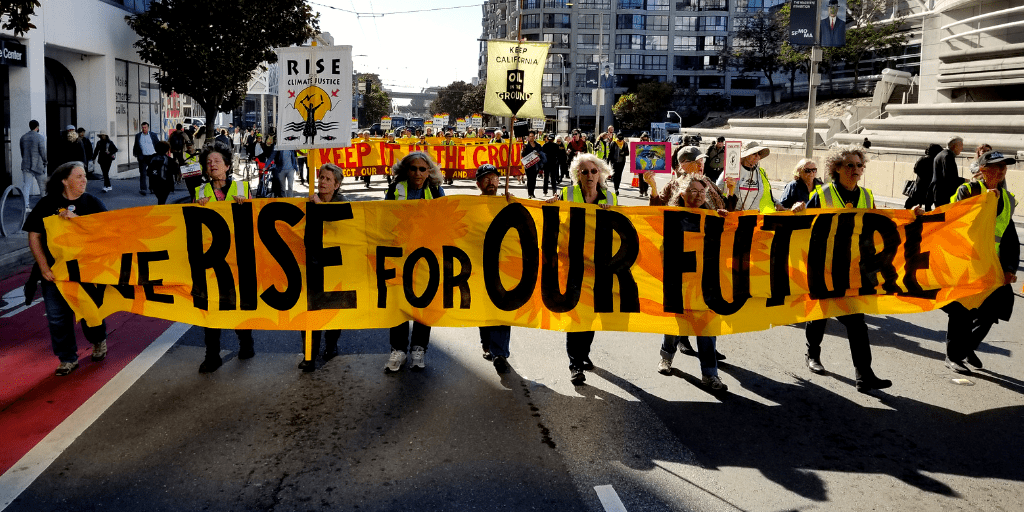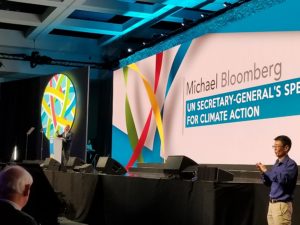We have much more to do and your continued support is needed now more than ever.
State Climate Policies Gain Steam, Help Save the Planet

Reflections on the Global Climate Action Summit and other signs of progress
Those of us who have been following climate change at a national level know that there hasn’t been much forward progress. While I firmly believe that we can and must adopt lasting, comprehensive, national-level climate solutions here in the nation’s capital (and give kudos to Republican Congressman Carlos Curbelo for introducing a federal carbon tax bill), major federal policy action is likely a long game.
Yet, the hard truth is, we don’t have much time left to stabilize our climate. Some scientists are now estimating that global greenhouse gas emissions must peak no later than 2020 and then decline to reach net zero emissions in 2050 to avoid a “tipping point” of runaway climate change. Already, we are seeing impacts that threaten our wildlife, such as the reduction of critical cold-weather habitat and an expansion in the range and lifetime of parasites like ticks.
Thankfully, states, cities, businesses, organizations, and advocates from around the world continue to ratchet up ambition to safeguard our climate, which will benefit people and wildlife alike. Such commitment was on display at the recent Global Climate Action Summit, and is also reflected in upcoming opportunities at the voting booth this November.
American Progress at the Global Climate Action Summit

Delegates from all over the world came to San Francisco in September to learn from and motivate each other, and to announce significant new actions to reduce climate pollution. Commitments came from multinational corporations, local and state policymakers, philanthropies, investors, non-governmental organizations, and others. Some of the most encouraging announcements from U.S. governors and mayors included:
- The U.S. Climate Alliance – a bipartisan coalition of U.S. governors upholding U.S. Paris Climate Agreement goals – has taken on new commitments to reduce short-lived climate pollutants, modernize the grid, bring down solar power costs, improve appliance energy efficiency standards, deploy more clean transportation, and identify best practices for capturing and storing carbon in forests, farms, and other ecosystems.
- Washington State, California, and three U.S. cities joined a global zero-emission vehicle (ZEV) alliance of states/regions, cities, and multinational businesses committing to using 100 percent public ZEV fleets by 2030, and nineteen U.S. cities formed the Electric Vehicle Purchasing Collaborative to drive down costs.
- In addition to linking with the Regional Greenhouse Gas Initiative, Virginia is joining the Transportation and Climate Initiative to cut carbon pollution from the transportation sector, developing an ocean acidification action plan, and putting together a framework to cut oil and gas sector and landfill-associated methane pollution – a climate super-pollutant.
- Connecticut, Maryland, New York, and California are crafting rules to phase out the use of hydrofluorocarbons (HFCs), a class of super-polluting greenhouse gases.
- States and cities along the West Coast committed to reduce food loss and waste by 50 percent by 2030 through the Pacific Coast Collaborative.
- Los Angeles committed to carbon neutrality by 2050.
- New York City pledged to double investments in clean energy and climate solutions to $4 billion over the next three years.
November is a Pivotal Moment in the Fight against Climate Change
The progress many states and cities are showing in protecting people and the environment from climate change is commendable and – speaking for wildlife already experiencing serious decline – greatly appreciated. There are hundreds of other less newsworthy but also important actions that local governments are taking across the country that help stabilize our climate, representing a broad swath of America. The combined effect is helping to fulfill roughly half of the greenhouse gas emissions reductions we agreed to in the Paris Climate Agreement in 2016 – a reduction of 26-28 percent below 2005 levels by 2025.
Science dictates that we can and must do more, which is why the National Wildlife Federation’s family of affiliated organizations in 51 U.S. states and territories adopted a policy resolution this year calling for greater climate ambition by all non-federal governments.
Fortunately, there are at least two excellent opportunities at the ballot box this November 6 to take even bolder climate action:
- Nevada: Question 6 – the Renewable Energy Promotion Initiative – will be on the November ballot to increase the amount of renewable energy that the state produces to 50 percent by 2030 (up from a current 25 percent requirement), taking advantage of ample solar and geothermal state resources.
- Washington State: Ballot Initiative 1631 would require big polluters of climate-altering greenhouse gases to pay a $15 fee for each ton of pollution released, giving them a strong and clear reason to reduce how much they pollute and to switch over to clean energy alternatives. Money raised from the fees will be used to invest in even more climate solutions for the state, and to help local communities and low-income residents.
All residents of Nevada and Washington State should VOTE YES on these initiatives.
And, of course, National Wildlife Federation urges all registered voters to choose candidates this upcoming election day who will fight to protect our climate and wildlife. #BeAClimateVoter






















